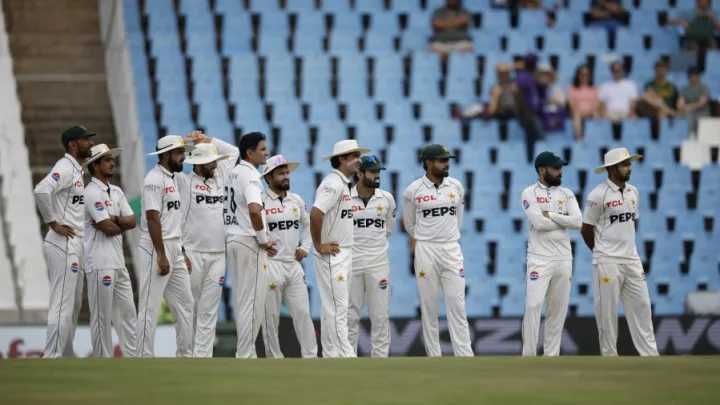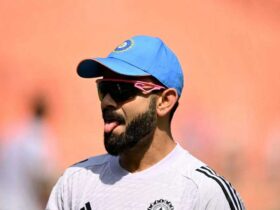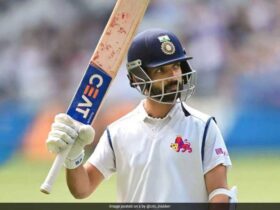There was some extremely exciting red-ball cricket being played by some Pakistanis on the third day of the Newlands Test. It’s an unusual thing to say for a day that saw some of Pakistan’s worst shot selection, and a day where they crumpled in a heap for 194, giving South Africa a 421-run lead, and effectively killing off any hopes Pakistan would break their interminable losing run in South Africa.
But that aforementioned exciting cricket wasn’t being played at Newlands; it was happening in Karachi at the Quaid-e-Azam Trophy (QeA) final, where a thrilling run-chase saw Sialkot beat Peshawar by one wicket.
The QeA this year is an appropriate bellweather of Pakistan’s relationship with Test cricket over the last year. In a year that saw the busiest home Test season for Pakistan this century, there was little information on when QeA would start, or what format it would assume. When eventually it did start, it began on October 26, almost as late as it ever has in the last 15 years. The format, too, was somewhat clunky, an expanded tournament comprising 18 teams played across a pool and triangular stage.
By that time, five of Pakistan’s seven home Test matches had already been played; the home season was almost done. September, the only window Pakistan had that hadn’t been packed with some international series or other, could have been spent in preparation for the red-ball winter; instead, Pakistan hosted, to much fanfare, a domestic 50-over tournament, to the bemusement and frustration of then red-ball coach Jason Gillespie. None of it, bar the final, was broadcast live, though the PCB was diligent with providing regular updates. The QeA final, clashing as it was with the Newlands Test, did not exactly capture public imagination.
This World Test Championship (WTC) cycle is gone. Yes, Pakistan have to play two Tests against West Indies later this month, but none of it really matters. This series was supposed to be held this time last year, but an overcrowded schedule squeezed it out. Pakistan are eighth on the WTC table, West Indies are ninth. This is a basement battle. The feast of the last six months will be followed by a prolonged famine; Pakistan do not play another Test until October, and just two in the next 14 months.
It is something their captain Shan Masood, appointed in the early stages of this cycle, has called on to change, but, despite his brief tenure, he is already the great survivor of the last year in Pakistan. Pakistan’s approach to Test cricket has been so furiously inconsistent that even a glut of Tests – as we saw this season – is unlikely to lead to improved results. They began the 18 months of this cycle with a demolition of Sri Lanka away from home under coach Grant Bradburn and director of cricket Mickey Arthur. The PCB branded it “the Pakistan Way”, ostensibly a long-term roadmap for how they aimed to play Test cricket.
By the time the next series came about, Bradburn, Arthur, the PCB chair, and captain Babar Azam had all been replaced, and references to the Pakistan Way were getting harder to find. Any encouragement they drew despite a whitewash in Australia was squandered when they were similarly swept aside at home by Bangladesh. By now, the chair as well as the coach had of course changed once more, and Pakistan had planned to prepare a pitch so juicy they played an all-pace attack in the first Test.
Just two Test matches on from both Gillespie and Masood indicating pace at home was a strategy they wanted to pursue, both had had their selection powers stripped from them, and Pakistan played all-spin attacks at home against England on raging surfaces. Another month and another change of coach later, Pakistan dropped Shaheen Afridi – or allowed him to sit out the Test series in South Africa to play the Bangladesh Premier League – and played four medium-fast bowlers at Newlands, sitting Naseem Shah out as well for good measure. (The official version that he had a stiff back is somewhat undercut by him bowling on the practice pitches a few strips away from the playing surface at tea on the second day, notably quicker than any of the four Pakistan actually fielded). Masood directly compared South Africa’s pace to Pakistan’s lack of it following the series loss, less as a point of criticism than just a statement of fact.
In Pakistan, there’s a leitmotif of existential crisis running through most setbacks, one which must be framed in terms of who is to blame, who can be sacked, or who the saviour can be. But a series loss in South Africa is in itself hardly a signifier of anything, because Pakistan have lost almost every series across every decade in South Africa.
They could not have played three high-pace, high-quality seamers like South Africa, because they simply don’t have them. They might have played Naseem, though he wasn’t exactly at the level of Kagiso Rabada or Marco Jansen in Centurion, and they might have played Noman Ali, though they do not have enough seam-bowling allrounders to do so without enfeebling a vulnerable batting line-up. The series result was more of an endpoint than a harbinger, of the rather boring fact that better Test teams are more likely to win Test matches than worse ones.
Perhaps none of this really matters, because all indications from the PCB is it has matters of greater import to deal with. It has spent the last few months working out the finer details of how it will go about hosting the Champions Trophy. All three stadiums that will see games are undergoing significant renovation, with the chair Mohsin Naqvi stating on multiple occasions construction work needed to happen “day and night” to make sure the venues will be ready on time. The PSL has moved into a new window that clashes with the IPL; just about every day of the South Africa Tests, a new player to have signed up for the draft was excitedly announced across the PCB media channels.
But Pakistan is not like a number of other cricketing nations, where people only care about it if it’s happening in a particular season, at a particular time or year, in a particular format or against a particular opposition. It is a de facto single sport country, where the official line is every game matters. As they look rather enviously over at South Africa, making plans to go Lord’s to play the WTC final, they know they are far off finding themselves in a situation where they, too, can realistically harbour such ambitions. For that, they will need to know what they want from Test cricket when it comes around again, so they do not squander it quite as profligately as they did this cycle.










Leave a Reply